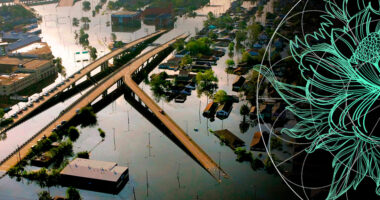Tropical Cyclone Jasper crossed the coast north of Cairns, tracking over the remote Indigenous community of Wujal Wujal. Damage from wind and storm surge was minimal, but Jasper still produced more than 800mm of rain across the Daintree and Mossman River catchments. This event highlights the increasing challenges posed by extreme weather conditions and their impacts on communities, infrastructure, and the insurance industry.
This extreme flood event bears some similarity to that which caused significant damage to Townsville in February 2019. Both were associated with a stationary convergence zone caused by a stalled tropical low located to their northwest.
In the case of Townsville, the tropical low did not budge for more than ten days. In that time, Townsville received the equivalent of a year’s average rainfall.

In the aftermath of ex-tropical cyclone Jasper, which made landfall on December 13, far north Queensland, Australia, is grappling with unprecedented flooding that has led to emergency rescues, power outages, and substantial material losses.
Some rain gauges in the Barron and Daintree River catchments recorded more than 2m of rain over recent days, and more rain is expected.
Water levels in the lower Barron River have smashed the previous record set by devastating floods in March 1977.
The full impacts of the flood are not yet clear. But there’s likely to be significant damage to properties and public infrastructure, and negative effects on industries such as tourism and agriculture. Recovery is likely to take many months.
Financial losses from Cyclone Jasper

According to Aon’s report, the situation, exacerbated by record-breaking torrential rainfall, has prompted warnings of financial losses potentially reaching into the hundreds of millions of AUD/USD.
Cyclone Jasper initially hit north of Cairns as a tropical storm, later weakening to below tropical cyclone intensity over the Cape York Peninsula.
The remnants of the cyclone, coupled with a developing surface trough, resulted in intense rainfall over already saturated river catchments.
The Australian Bureau of Meteorology reported staggering 7-day rainfall totals, with some areas recording over 2,000 mm (78.7 inches) of rain. The city of Cairns itself experienced at least 650 mm (25.6 inches) of rainfall during this event.
Extent of the Flooding

Cyclone Jasper brought more than 2 meters of rain to far north Queensland, causing unprecedented flooding across the region, according to Australian Geographic.
This included record-breaking water levels in rivers such as the Barron and Daintree, surpassing previous records set in the 1970s.
The severe flooding forced evacuations, left residents stranded, and resulted in significant damage to infrastructure like roads and the Cairns airport.
Once the immediate crisis in North Queensland has subsided, local and state authorities will need to grapple with how to deal with the “new normal” of extreme weather events.
Since the big Barron River flood in March 1977, considerable residential and commercial development has been permitted across the river’s floodplain. In many cases, these earlier developments were approved without full consideration of future floods. Many were also approved before local government planning started taking sea level rise into consideration.
The wider Cairns community will recover from this extreme event and will hopefully take on board any problems identified in the emergency responses. In future, emergency planning must take the effects of climate change more seriously. This includes increases in sea level, and more intense tropical cyclones, storm surges, rainfall and flooding.
Path and Impact of Cyclone Jasper

The cyclone crossed the coast north of Cairns and initially caused moderate damage. However, immense rainfall followed, cutting off towns and inundating houses. There were concerns about sewage-contaminated floodwater, a condition known as “blackwater” in the insurance industry, which poses additional risks and complications for recovery efforts.
Power outages affected approximately 14,000 people, with the local airport in Cairns submerged, resulting in canceled flights on December 16-17.
Local officials are expressing concern about potential infrastructure damage leading to a loss of access to drinking water.
As assessments continue in the affected area, the economic and insured losses caused by Cyclone Jasper and the subsequent flooding are expected to be higher than initially estimated.
Although the impacted region was sparsely populated, significant damage to properties, vehicles, infrastructure, and agriculture has been reported.
Responding to damage caused by ex-tropical cyclone Jasper, the Insurance Council of Australia (ICA) has declared the event an ‘Insurance Catastrophe’, noting that 3,800 claims have already been lodged across areas stretching from Cape York Peninsula to Mackay.
Insurance Claims and Concerns

As of the report, at least 1,870 claims had been lodged with insurers, and this number was expected to increase. A major concern was that many damages occurred after the 48-hour time limit set by the Commonwealth reinsurance pool for cyclone-related claims.
This situation raised the prospect of insurers or their own private reinsurance contracts bearing the cost of claims, potentially leading to increased premiums. The private reinsurance contracts for insurers typically have a seven-day claims limit.
Insurers will be on the hook to cover a large chunk of claims stemming from record Queensland floods because a Commonwealth support system designed to keep premiums low in disaster zones will be mostly off limits.
According to Australian Financial Review, the former Morrison government established a $10 billion taxpayer backed reinsurance pool for cyclones, but floods in Cairns and surrounds will be the first test of the venture’s contentious 48-hour time limits on when insurers can claim against the pool.
Response from Insurance Companies
Companies like RACQ, Sure Insurance, Allianz, and IAG reported hundreds of claims each. David Carter, the CEO of RACQ, mentioned that some claims would be covered by the federal pool, while others would fall under RACQ’s private reinsurance program. Suncorp, another major insurer in the region, reported 500 claims as of the report.
Comparisons to Previous Events
The flooding caused by Cyclone Jasper bore some similarities to the significant damage experienced in Townsville in February 2019. Both events were associated with a stationary convergence zone caused by a stalled tropical low. However, the two events differed in their climatic contexts and the conditions in which they formed.
Broader Climate Considerations
With 2023 closing as one of the warmest years on record, there is growing global concern about the rise of extreme weather events, including floods, droughts, and heatwaves.
The atmosphere and oceans are warming due to increasing emissions of greenhouse gases, leading to a greater risk of extreme rainfall and flooding events like those seen in far north Queensland.
In the aftermath of Cyclone Jasper, local and state authorities are expected to face challenges in dealing with the new normal of extreme weather events. There is a need for emergency planning that seriously considers the effects of climate change, including rising sea levels and more intense tropical cyclones.
………………….
AUTHOR: 








